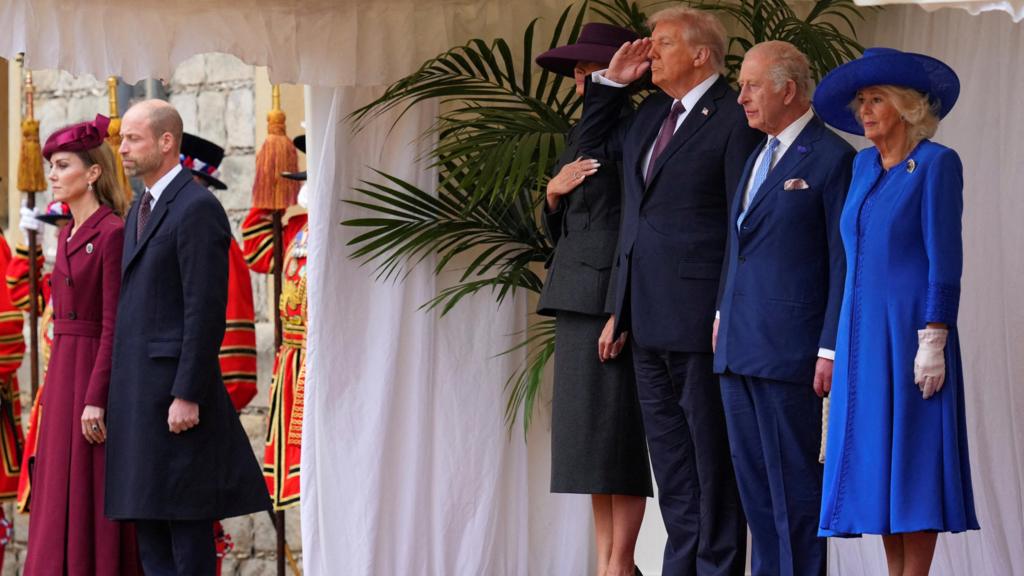Donald Trump’s Windsor Castle Visit: Welcomed by King Charles and Senior Royals
When former U.S. President Donald Trump set foot on British soil once again, the atmosphere was charged with anticipation, diplomacy, and a dose of controversy. His visit to Windsor Castle, where he was greeted by King Charles III and senior members of the royal family, marked one of the most closely watched international meetings of 2025. The event has stirred discussions about tradition, politics, transatlantic relations, and the symbolic weight carried by royal ceremonies.
This article explores in detail the significance of Trump’s Windsor Castle visit, the royal family’s role in welcoming him, the political and diplomatic context, the symbolism of royal protocol, and the broader implications for U.S.-UK relations.
A Royal Welcome in Historic Surroundings
Windsor Castle, a fortress and residence that has witnessed centuries of British history, provided the backdrop for Trump’s meeting with King Charles. The castle’s grandeur, combined with its association with stability and tradition, made it a fitting stage for a visit steeped in symbolism.
Trump, accompanied by his delegation, was greeted by a ceremonial guard of honor. King Charles, dressed in formal royal attire, personally welcomed the former U.S. President in the quadrangle, following the long-standing royal practice of honoring distinguished state guests. Senior royals, including Queen Camilla, Prince William, and Princess Anne, also took part in different stages of the welcome, signaling the importance placed on this encounter.
Why This Visit Matters
Trump’s relationship with the United Kingdom has always been a subject of scrutiny. During his presidency (2017–2021), he met Queen Elizabeth II several times, most notably at Windsor Castle in 2018, when images of the Queen and Trump walking together became global headlines. Now, returning as a former president but still a powerful figure in American politics, his meeting with King Charles carried fresh layers of meaning.
Key points of importance include:
Continuity of Diplomatic Relations – Regardless of political shifts in Washington or London, the monarchy serves as a stabilizing symbol of friendship.
Royal Neutrality and Political Symbolism – While the royal family is officially apolitical, their interactions with foreign leaders are closely analyzed for hidden meanings.
Trump’s Political Relevance – With Trump positioning himself strongly in U.S. politics again, his visit was not seen merely as ceremonial but as potentially laying the groundwork for future state-level engagement.
The Role of King Charles III
For King Charles, who ascended the throne in 2022 following the passing of Queen Elizabeth II, this meeting was part of his ongoing mission to redefine the monarchy’s role in the modern world. Charles is known for his strong views on climate change, sustainability, and social issues—areas where Trump has often held opposing stances.
Observers noted that while the public welcome followed strict royal protocol, the private discussions likely touched on sensitive global topics:
Climate action and international cooperation.
Trade and economic partnerships post-Brexit.
NATO and defense commitments.
Global security challenges, including conflicts in Europe and the Middle East.
The King’s ability to balance formality with subtle diplomacy was put to the test, as every gesture was closely monitored by the press and analysts.
The Presence of Senior Royals
Unlike some past visits where the Queen conducted much of the hosting herself, this event featured a stronger presence of multiple royals:
Queen Camilla: Played the role of gracious hostess, accompanying Melania Trump (if present) or Trump’s delegation in private tours and luncheons.
Prince William: As heir to the throne, his presence signaled continuity and future stability of the monarchy’s diplomatic role.
Princess Anne: Known for her no-nonsense approach, her involvement emphasized the monarchy’s consistency in upholding state traditions.
Their collective presence highlighted the monarchy’s strategy of presenting itself as a unified institution, not centered on one figure but a network of representatives.
Pageantry and Protocol
Royal visits are as much about spectacle as diplomacy. The Windsor Castle event included:
Inspection of the Guard – Trump walked alongside King Charles as they reviewed the ceremonial troops, an echo of his 2018 visit with Queen Elizabeth.
Formal Tea and Luncheon – A long-standing royal tradition, where private discussions often take place away from cameras.
Exchange of Gifts – Symbolic items, often highlighting British craftsmanship and history, were presented to Trump.
Such rituals reinforce the sense of continuity that the monarchy embodies.
Public Reaction in Britain
As with most Trump-related events, reactions in the UK were mixed.
Supporters praised the royal family for upholding tradition and treating the former president with respect, pointing to the importance of U.S.-UK relations regardless of political divides.
Critics questioned the optics of granting Trump such a warm welcome, given controversies surrounding his political legacy and legal challenges in the U.S.
Media Outlets split along predictable lines: some highlighted Trump’s statesman-like reception, while others emphasized protests and criticism outside Windsor.
Street demonstrations in London and Windsor were reported, though not on the scale seen during his 2019 state visit.
The U.S. Angle
From an American perspective, Trump’s Windsor Castle visit was broadcast widely, especially by outlets supportive of his political ambitions. It was framed as:
Proof of his enduring global relevance.
Evidence of strong U.S.-UK ties under his leadership.
A contrast with current U.S. administration diplomacy.
Critics in the U.S., however, saw it as an attempt at international stagecraft to boost his political image rather than genuine diplomacy.
Comparing with Previous Visits
Trump’s earlier encounters with the royal family provide useful context:
2018 Windsor Castle Visit – Meeting Queen Elizabeth, walking ahead of her during inspection of the guard caused debates about protocol.
2019 State Visit – A full ceremonial welcome, including a banquet at Buckingham Palace, drew large protests in London.
This 2025 visit was less of a state occasion and more of a diplomatic courtesy, yet its symbolism was equally powerful.
Broader Diplomatic Implications
The Windsor Castle meeting underscores how royal engagements complement government diplomacy. While the Prime Minister and official political channels handle direct negotiations, the monarchy provides a softer, symbolic bridge that emphasizes continuity and shared heritage.
Possible diplomatic outcomes:
Renewed conversations on U.S.-UK trade.
Stronger emphasis on NATO defense ties.
A cultural reaffirmation of the “special relationship.”
Even if no formal agreements were signed, the imagery of Trump shaking hands with King Charles will resonate globally.
Symbolism of Royal Engagements
Royal meetings are never casual. They convey:
Legitimacy – Welcoming Trump signals recognition of his continued influence.
Tradition – The monarchy’s apolitical stance allows it to host even divisive figures while maintaining neutrality.
Continuity – Regardless of changes in government, the royal family provides a sense of timeless stability.
Critics and Controversies
No Trump visit would be complete without controversy. Key criticisms included:
Timing – Some questioned whether Trump’s presence distracted from pressing domestic issues in the UK.
Protocol Concerns – Analysts speculated whether Trump would adhere to strict royal etiquette this time.
Political Exploitation – Critics accused Trump of using the royal stage for campaign optics.
Despite this, the monarchy maintained its neutral stance, focusing on tradition rather than politics.
Media Coverage and Narratives
British tabloids focused on the spectacle—the handshakes, outfits, and ceremonial details—while U.S. networks leaned heavily on the political implications. Global outlets emphasized the unusual nature of a royal welcome for a former president, highlighting both admiration and criticism.
Looking Forward
The Windsor Castle visit may be remembered less for what was said behind closed doors and more for the images it produced: Trump and King Charles standing side by side in one of the world’s most historic castles.
It reinforces the monarchy’s role as a diplomatic anchor and shows how the U.S.-UK relationship, often called the “special relationship,” is as much about symbolism as substance.
For Trump, it was an opportunity to remind both Americans and the world of his enduring presence on the global stage. For King Charles, it was another test of his ability to carry forward his mother’s legacy of diplomatic tact while subtly steering the monarchy into a new era.
Conclusion
Donald Trump’s Windsor Castle visit, hosted by King Charles and attended by senior royals, was more than just ceremony. It was an event rich in symbolism, tradition, and political undertones.
While critics debated its appropriateness, and supporters praised its diplomacy, one thing is clear: the encounter once again underscored the unique interplay between monarchy and politics, between tradition and modern statecraft, and between the U.S. and the UK as enduring allies.
As history unfolds, this meeting will likely stand as another chapter in the long story of royal engagements with American leaders—a story where images and symbolism often matter just as much as the policies debated behind closed doors.
http://Donald Trump Windsor Castle visit King Charles royals



